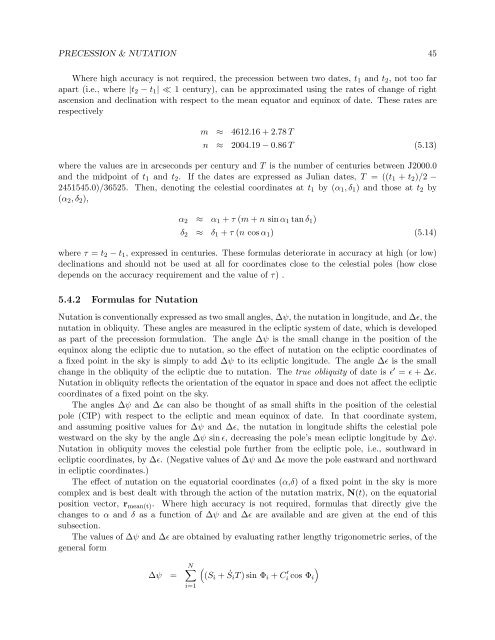USNO Circular 179 - U.S. Naval Observatory
USNO Circular 179 - U.S. Naval Observatory
USNO Circular 179 - U.S. Naval Observatory
Create successful ePaper yourself
Turn your PDF publications into a flip-book with our unique Google optimized e-Paper software.
PRECESSION & NUTATION 45<br />
Where high accuracy is not required, the precession between two dates, t1 and t2, not too far<br />
apart (i.e., where |t2 − t1| ≪ 1 century), can be approximated using the rates of change of right<br />
ascension and declination with respect to the mean equator and equinox of date. These rates are<br />
respectively<br />
m ≈ 4612.16 + 2.78 T<br />
n ≈ 2004.19 − 0.86 T (5.13)<br />
where the values are in arcseconds per century and T is the number of centuries between J2000.0<br />
and the midpoint of t1 and t2. If the dates are expressed as Julian dates, T = ((t1 + t2)/2 −<br />
2451545.0)/36525. Then, denoting the celestial coordinates at t1 by (α1, δ1) and those at t2 by<br />
(α2, δ2),<br />
α2 ≈ α1 + τ (m + n sin α1 tan δ1)<br />
δ2 ≈ δ1 + τ (n cos α1) (5.14)<br />
where τ = t2 − t1, expressed in centuries. These formulas deteriorate in accuracy at high (or low)<br />
declinations and should not be used at all for coordinates close to the celestial poles (how close<br />
depends on the accuracy requirement and the value of τ) .<br />
5.4.2 Formulas for Nutation<br />
Nutation is conventionally expressed as two small angles, ∆ψ, the nutation in longitude, and ∆ɛ, the<br />
nutation in obliquity. These angles are measured in the ecliptic system of date, which is developed<br />
as part of the precession formulation. The angle ∆ψ is the small change in the position of the<br />
equinox along the ecliptic due to nutation, so the effect of nutation on the ecliptic coordinates of<br />
a fixed point in the sky is simply to add ∆ψ to its ecliptic longitude. The angle ∆ɛ is the small<br />
change in the obliquity of the ecliptic due to nutation. The true obliquity of date is ɛ ′ = ɛ + ∆ɛ.<br />
Nutation in obliquity reflects the orientation of the equator in space and does not affect the ecliptic<br />
coordinates of a fixed point on the sky.<br />
The angles ∆ψ and ∆ɛ can also be thought of as small shifts in the position of the celestial<br />
pole (CIP) with respect to the ecliptic and mean equinox of date. In that coordinate system,<br />
and assuming positive values for ∆ψ and ∆ɛ, the nutation in longitude shifts the celestial pole<br />
westward on the sky by the angle ∆ψ sin ɛ, decreasing the pole’s mean ecliptic longitude by ∆ψ.<br />
Nutation in obliquity moves the celestial pole further from the ecliptic pole, i.e., southward in<br />
ecliptic coordinates, by ∆ɛ. (Negative values of ∆ψ and ∆ɛ move the pole eastward and northward<br />
in ecliptic coordinates.)<br />
The effect of nutation on the equatorial coordinates (α,δ) of a fixed point in the sky is more<br />
complex and is best dealt with through the action of the nutation matrix, N(t), on the equatorial<br />
position vector, r mean(t). Where high accuracy is not required, formulas that directly give the<br />
changes to α and δ as a function of ∆ψ and ∆ɛ are available and are given at the end of this<br />
subsection.<br />
The values of ∆ψ and ∆ɛ are obtained by evaluating rather lengthy trigonometric series, of the<br />
general form<br />
∆ψ =<br />
N<br />
i=1<br />
<br />
(Si + ˙ SiT ) sin Φi + C ′ <br />
i cos Φi


